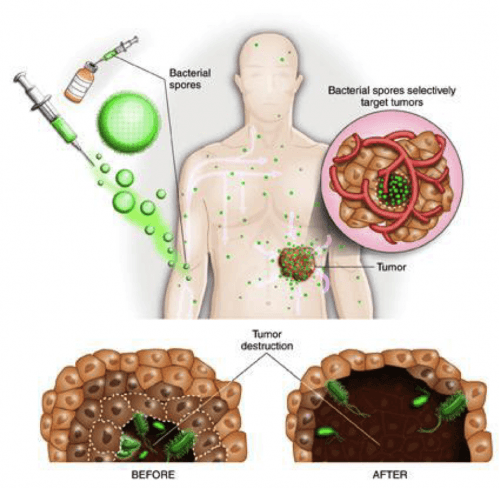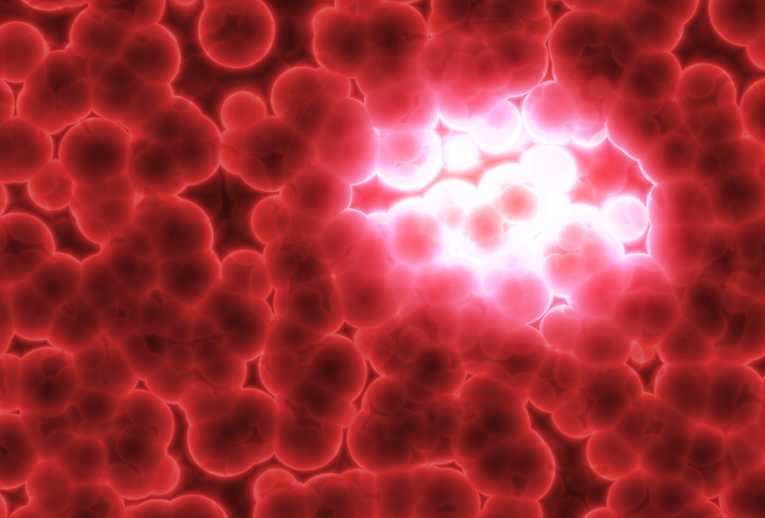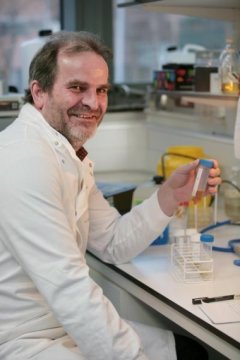Cancerous tumors may just have met their nemesis, according to scientists speaking at the autumn conference of the Society for General Microbiology, which kicks off the UK tomorrow. But the fatal blow being delivered to dangerous tumors comes from an unlikely source – soil-dwelling bacteria, that have a special attraction for conditions found at a tumor’s heart. This new therapy – the result of collaboration between the UK-based University of Nottingham, and University of Maastricht, in Holland – should enter clinical trials within 2 years.
The bacterium being harnessed is widespread, harmless and has been on the planet for billions of years. Team leader, Professor Nigel Minton, described them: “Clostridia are an ancient group of bacteria that evolved on the planet before it had an oxygen-rich atmosphere and so they thrive in low oxygen conditions. When Clostridia spores are injected into a cancer patient, they will only grow in oxygen-depleted environments, i.e. the center of solid tumors.” This makes them ideal ‘trojan horse’ candidates for targeting tumors.
‘Exquisitely specific’ line of attack “This is a totally natural phenomenon, which requires no fundamental alterations and is exquisitely specific. We can exploit this specificity to kill tumor cells but leave healthy tissue unscathed,” said Professor Minton. The trick to turning this selectivity into a tumor-killing therapy lies with giving the bacteria a weapon of attack. That comes from the insertion of an enzyme-producing gene into the Clostridia’s DNA. It is tuned-in to unlock a cancer-destroying ‘pro-drug’.
Researchers at Johns Hopkins Hospital are testing a new cancer treatment that uses bacteria to kill tumors, and chordoma may be an ideal candidate for this new treatment. Below is an excerpt from an announcement made by the study’s leaders explaining the rationale for recruiting chordoma patients for this trial.
Hypoxia Targeting Therapy for Chordomas
One of the hallmarks of many solid tumors, especially chordomas, is that they contains areas of low oxygen, otherwise known as hypoxia. These areas arise because tumor cells grow so quickly, they outpace the blood supply that brings in oxygen. For many reasons, the cancer cells that lie in these hypoxic portions of the tumor are resistant to standard chemo and radiation therapies.
The Enemy of my Enemy

Currently, very little can be done to completely destroy hypoxic tumor cells. However, certain types of bacteria grow only in low oxygen or anaerobic conditions. Research in mice and other animals has shown that anaerobic bacteria seek out low-oxygen environments and destroy hypoxic tumor cells, while leaving normal tissue unharmed. And, once they’re done destroying tumor cells they can be easily killed by commonly available antibiotics.
It’s hard to imagine that one could use bacteria to treat cancer. However, this type of cancer treatment has deep scientific roots. As long ago as the 1890s, a doctor named William B. Coley discovered a curious fact: occasionally, cancer patients who underwent surgery and developed a bacterial infection afterwards became completely cured of their tumors. In the nineteenth century scientists didn’t have the tools to fully understand the significance of this finding, but Coley’s work nevertheless got people thinking about the potential of bacteria to treat illnesses like cancer.
It wasn’t until over a half century later though, in the 1950s and 1960s, that researchers tried using an anaerobic bacterium, Clostridium butyricum, to fight cancer. This method worked. C. butyricum destroyed large portions of tumors in treated patients. However, a major problem emerged. Scientists then could not completely control the bacteria. While the bugs were susceptible to antibiotics, they still produced toxins that made patients sick. The use of anaerobic bacteria to treat tumors was put on hold and radiation and chemotherapies became standard.
“This is a totally natural phenomenon, which requires no fundamental alterations and is exquisitely specific. We can exploit this specificity to kill tumor cells but leave healthy tissue unscathed,” said Professor Minton. The trick to turning this selectivity into a tumor-killing therapy lies with giving the bacteria a weapon of attack. That comes from the insertion of an enzyme-producing gene into the Clostridia’s DNA. It is tuned-in to unlock a cancer-destroying ‘pro-drug’
Professor Nigel Minton works at the University of Nottingham.
The genetic revolution in the last half of the twentieth century fundamentally altered scientists’ abilities to manipulate the DNA of all kinds of organisms. One of the results was that they could create different types of bacteria from existing strains—ones that never before existed.
In the early 2000s, scientists at Johns Hopkins University used genetic engineering to create a strain of Clostridium that lacked the ability to produce toxic proteins. They called this bacterium Clostridium novyi-NT, where the NT stands for non-toxic. Researchers then began using C. novyi-NT in mice to see if it could cure cancer and if there were any ill effects from the bacterium itself.
In one study, 30% of mice treated with spores of the genetically engineered C. novyi-NT were cured of cancer and nearly all had a significant response. Not only did the anaerobic bacteria destroy existing hypoxic tumor cells, it provoked the mouse’s immune system to recognize cancer cells as a type of foreign agent. When the cured mice were injected with new cancer cells, they destroyed the cancer before it had a chance to grow and form tumors.
This type of bacterial therapy may both help destroy existing tumors and force certain types of cancer into complete remission. And since the bacterium lacked toxic proteins, the side effects were easily managed.
Clinical Trial
C. novyi-NT is currently in an FDA sanctioned phase I clinical trial at the Johns Hopkins Hospital. Chordomas are thought to be very hypoxic and this could be part of the reason why standard chemotherapies have historically failed in chordoma patients. We are currently enrolling patients to understand how people with recurrent chordomas arising in the sacrum respond to this therapy.













